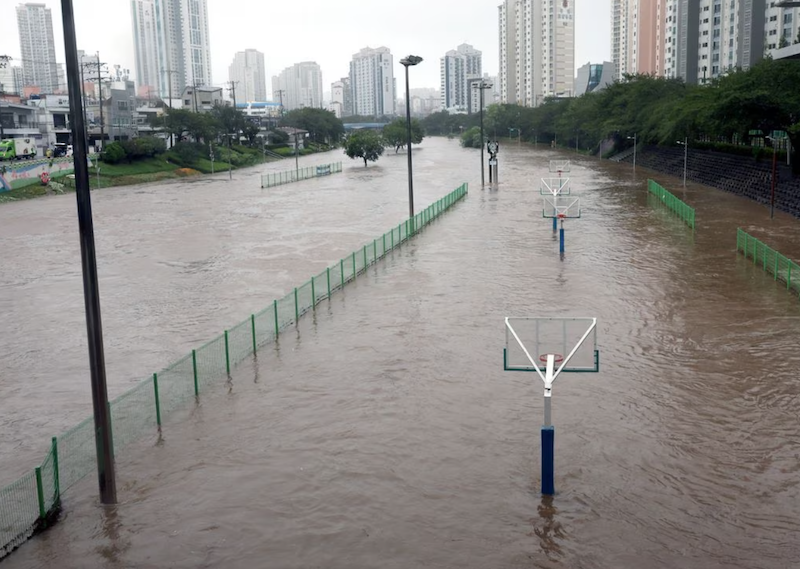South Korean authorities evacuated more than 10,000 people, closed schools and cancelled flights as tropical storm Khanun tore across the peninsula on Thursday.
Downgraded from a typhoon to a tropical storm, Khanun made landfall on the southeast coast, and was heading towards the South Korean capital Seoul, having pounded southern Japan over the past week.
Khanun could also strike North Korea’s capital, Pyongyang, and state media there reported that the military and the ruling party had been ordered to prepare flood-mitigation measures and salvage crops.
Also on AF: India Emissions See Big Fall; Jakarta World’s Most Polluted City
In South Korea, some 350 flights and 410 train routes were cancelled, and more than 10,000 people were moved to safety, the interior ministry said. No casualties were reported.
The storm brought up to 60mm (2.36in) of rain per hour in some east coast towns, and maximum wind speeds of 126kph (78mph) in the southeastern port city of Busan, the weather agency said.
Khanun was passing South Korea’s central province of North Chungcheong as of 16:30 p.m. (0730 GMT), picking up a little speed as it moved northwards at 31 kph (19 mph) toward the greater Seoul area.
Most schools were shut for the summer vacation, but of those offering summer classes nearly half, about 1,600, either closed or switched to remote learning because of the storm, the education ministry said. Some schools in the eastern coastal province of Gangwon were hit by floods and landslides.
The storm compounded the misery for 37,000 youngsters attending the ill-starred World Scout Jamboree. Having endured a heatwave last week, they were moved to safer accommodation on Tuesday as their campsite lay in the path of the storm.
The country is still recovering from intense monsoon rain last month, which left more than 40 people dead, including 14 in a flooded tunnel.
‘Stronger Typhoons in Future’
Lee Hyun-ho, a professor of atmospheric science at Kongju National University, said Khanun was the first storm to pass directly over the Korean peninsula. He said increasing sea surface temperatures had made it more powerful.
“The more the temperatures rise, the greater the energy that storms can get. So we will likely see even stronger typhoons in the future,” Lee said.
Fed by humid air from the storm, heavy rain was still battering parts of western Japan, with some areas getting well over the normal for August in the past week. One town had recorded 985mm (38.78in) as of Thursday morning.
Another storm, Typhoon Lan, was approaching near the Ogasawara Islands, about 1,000km (621 miles) south of Tokyo, late on Wednesday.
Though the storm’s path was uncertain, the Japan Meteorological Agency said it could affect the Tokyo area by the end of the weekend.
The bad weather is striking in the middle of Obon, Japan’s main summer holiday, when many people leave big cities to return to their home towns.
Typhoon Khanun brought heavy rain in southern regions of Japan as it continues to head towards South Korea where it could make landfall on Thursday.
- Reuters with additional editing by Sean O’Meara
Read more:
Impact of Floods in China From Typhoon Doksuri Rises
Typhoons, Floods, Heatwaves Cost China Economy $5.7bn in July
Typhoon Storms Hit Northeast China; Factories, Farms Swamped
Beijing, Northern China Counts Cost as Typhoon Doksuri Kills 20
























